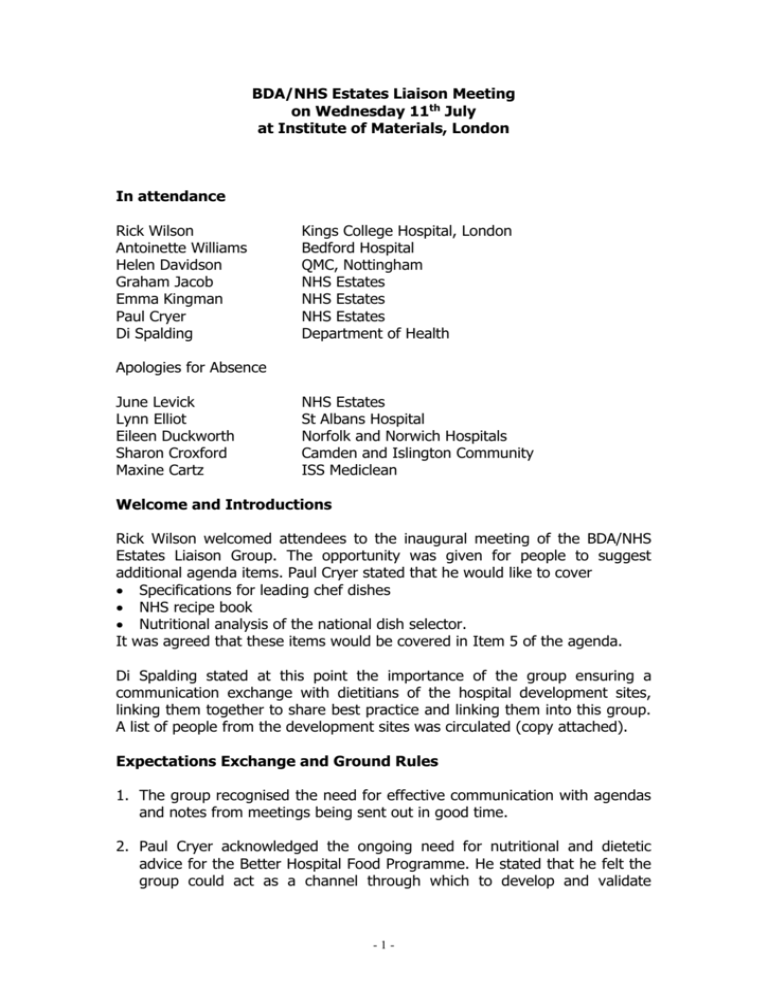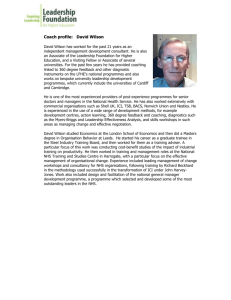Meeting notes 11 July 2001 - Hospital Caterers Association
advertisement

BDA/NHS Estates Liaison Meeting on Wednesday 11th July at Institute of Materials, London In attendance Rick Wilson Antoinette Williams Helen Davidson Graham Jacob Emma Kingman Paul Cryer Di Spalding Kings College Hospital, London Bedford Hospital QMC, Nottingham NHS Estates NHS Estates NHS Estates Department of Health Apologies for Absence June Levick Lynn Elliot Eileen Duckworth Sharon Croxford Maxine Cartz NHS Estates St Albans Hospital Norfolk and Norwich Hospitals Camden and Islington Community ISS Mediclean Welcome and Introductions Rick Wilson welcomed attendees to the inaugural meeting of the BDA/NHS Estates Liaison Group. The opportunity was given for people to suggest additional agenda items. Paul Cryer stated that he would like to cover Specifications for leading chef dishes NHS recipe book Nutritional analysis of the national dish selector. It was agreed that these items would be covered in Item 5 of the agenda. Di Spalding stated at this point the importance of the group ensuring a communication exchange with dietitians of the hospital development sites, linking them together to share best practice and linking them into this group. A list of people from the development sites was circulated (copy attached). Expectations Exchange and Ground Rules 1. The group recognised the need for effective communication with agendas and notes from meetings being sent out in good time. 2. Paul Cryer acknowledged the ongoing need for nutritional and dietetic advice for the Better Hospital Food Programme. He stated that he felt the group could act as a channel through which to develop and validate -1- information before being added to the Nutrition and Dietetics section of the web site. 3. Rick Wilson stated that the BDA were drawing up a consensus statement which would ensure that the group properly represented the views of the BDA. 4. Paul Cryer advised the group that NHS Estates were keen to enhance the involvement and status of dietitians in relation to planning and management of hospital catering services. Di Spalding noted that she had concerns about the number of dietitians involved in this work at present and the ability of the profession to provide for adequate numbers in the future given current training arrangements and recruitment and retention concerns. 5. It was noted that the group should have sufficient members to allow for a natural level of non-attendance given day to day business pressures on all involved. 6. Rick Wilson stated that both sides of the group should feel comfortable to be able to constructively criticise. Terms of Reference for the group The group would meet quarterly. The following general statement was agreed “To provide a forum for the representation of professional dietetic and nutritional advice to the NHS Estates Better Hospital Food programme”. It was also agreed that the group would undertake some works associated with the BHF programme and not act solely as an advisory function, although it is recognised that members of the group are in full time employment elsewhere. That the work programme for the group related only to England although approaches for information from other countries – especially those within the UK -would be positively considered on a case by case basis. It noted that health economies in Scotland, N Ireland and Wales would be able to access nutritional information held on the Hospitals Only part of the www.betterhospitalfood.com web site. Graham Jacob to advise the three territorial departments to this effect. Rick Wilson would be the Chair of the group for the first 12 months, setting the agenda in consultation with Graham Jacob. It was agreed that the official title of the group would be “BDA/NHS Estates - Better Hospital Food Development Group. -2- Agenda Items 1. It was noted that the BDA are putting together a national consensus statement to ensure all nutritional and dietetic advice is provided in a consistent fashion concerning the BHF programme. This will apply equally to acute and non-acute sectors. The timescale for the statement is that it will be approved by the end of the year. 2. Paul Cryer stated that he felt that dietetics had a new responsibility within the Better Hospital Food Programme – part of which included leading nutrition policy development, providing guidance and advise which enhanced the regular analysis of hospital menus, the development of exciting recipes and ensuring that they became an integral part of the catering team at hospital level. 3. It was noted that the BDA have virtually 100% membership State Registered Dietitians in the UK and therefore any statements issued would have a significant impact. 4. It was noted that June Levick from NHS Estates will be providing an Excel spreadsheet on the web site in week commencing 16th July with the nutritional analysis of all dishes in the National Dish Selector Group members were asked to review this and advise Mrs Levick of any issues arising concerning accuracy. 5. It was noted that next week PASA (Purchasing and Supply Agency) would be issuing specifications to 26 food supply companies and firms who have expressed an interest in submitting tenders for the national prepared meals contract. The new standardised Leading Chef recipes will be included in PASA specifications and should be widely available be December 2001 through this formal arrangement. 6. It was noted that 5 commercial firms were about to launch their range of Leading Chef dishes (some are already available). It was also noted that the number of dishes under general development by Leading Chefs would take the total recipes to +100 by December this year and that these would be introduced as completed from October onwards. Commercial firms have all expressed their willingness to continue in expanding the range available during the year. 7. It was noted that the nutritional planning model used for determining the nutritional content of the new NHS Menu had proved a useful and easy to use tool. It was agreed that this should be made available to all hospitals as a resource and Rick Wilson agreed to review the construction of the model and prepare a methodology for this purpose in conjunction with group members. -3- Once developed the model would be placed on the web site so all hospitals can download and use. 8. The group considered the need to set out a nutritional specification for each meal of the day. The emphasis on daily analysis of nutritional intake being promoted through National RNIs worked against the need for analysis by meal. It was also noted that the notion of a “meal” could not be sufficiently defined for there to be any meaningful guidance. The group decided not to pursue this. However – it was agreed that certain limited criteria be established for prepared meals which would set out the minimum levels for the inclusion of certain micro nutrients and the upper limit for those which are deemed to need restriction in each dish. The group would consider these criteria and advise June Levick so PASA can include this in their current round of discussion with manufactures in relation to the national prepared meals contract. 9. It was however also agreed that criteria be developed along similar lines for use in hospitals although these would allow for a range of micronutrients so that the needs of different patient groups can be accommodated. 10. It was noted that there needs to be more lower fat foods in the National Dish Selector and group members agreed to prepare a list for consideration by the Dish Development Team. 11. It was agreed that although the content of the Snack Boxes was determined by local need there should be a review of the nutritional guidance for the content of Snack Boxes. 12. It was also agreed to provide some guidance concerning the 2 new snacks per day and group members agreed to provide a list of possible snacks at around the 150Kcal mark. It was agreed that hospitals should be discouraged from providing meagre snacks via this calorie marker. 13. The group supported the use of home made soups for patients but agreed that setting nutritional specification might be premature and further consideration is required. 14. Paul Cryer briefly outlined thoughts for 2002/02 in relation to the BHF programme. It would likely feature a "Safer Food" programme, further support for health promotion issues and considerations for a standard operating platform for catering services in the NHS to enhance consistent high quality standards across the country. 15. A retail NHS Menu Book is being considered which links good nutrition with recovery from illness and that it was possible that this would be -4- published in Spring 2002. It was agreed that this should have a strong nutritional content. 16. It was agreed that group members would seek out high profile doctors and nutrition scientists who may give support to this project. 17. The group reviewed the possibility of supporting some research which examines links between good nutrition and drugs/supplements costs in hospitals. The group considered a number of research proposals and agreed that this should be referred to the BDA main group for consideration so that the right subject area is properly defined before progressing this further. Benefits and Concerns Rick Wilson invited group members to share the benefits and concerns they had individually about the meeting. This is a protocol advanced by Gemini Consulting as a useful opportunity for feedback and learning. Generally the group felt; The meeting provided an excellent opportunity to exchange information, and to build relationships between the BDA and NHS Estates. Concern was raised in relation to the need to get sufficient numbers at meetings so that adequate representation is achieved – it was agreed to provide as much notice as possible of meeting dates and keep the agenda lively and productive. Concern was also raised as to how to ensure that the work gets done. It was agreed that individuals would take responsibility for particular actions (next steps) and Emma Kingman would be responsible for progress chasing in between meetings. Date, time and place of next meetings 1. 2. 5th September, 11.00am – 3.30pm - location to be advised 6th November, 11.00am – 3.30pm – location to be advised -5-




